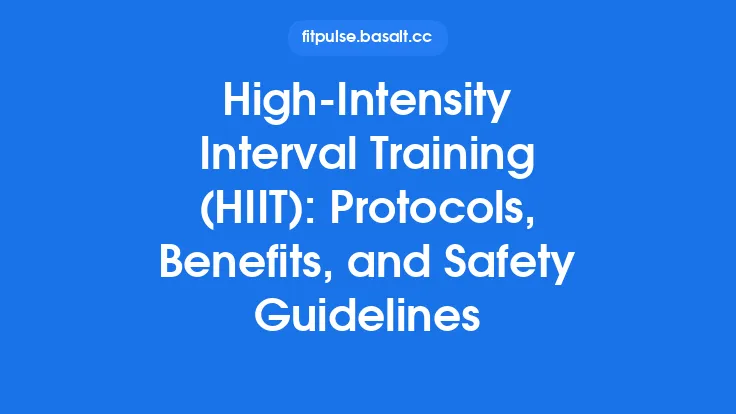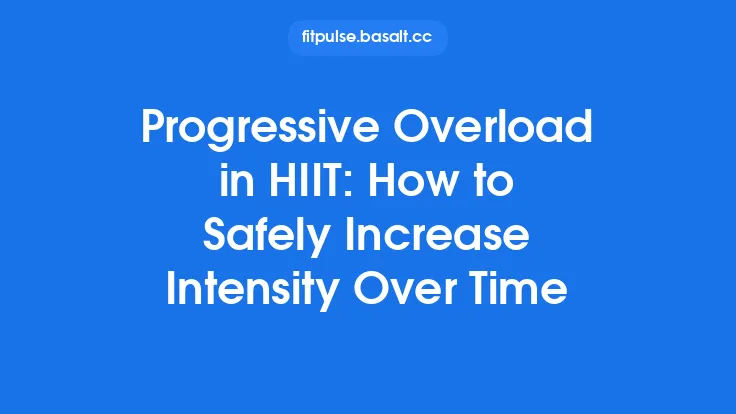High‑intensity interval training (HIIT) has become a cornerstone of modern exercise prescription because it elicits profound metabolic remodeling in a relatively short amount of time. Unlike traditional steady‑state endurance work, HIIT consists of repeated bouts of supramaximal effort interspersed with brief recovery periods. This pattern creates a unique metabolic environment that forces skeletal muscle, adipose tissue, and the cardiovascular system to adapt at the cellular and molecular levels. The adaptations that develop are not merely transient responses to a single session; with consistent training they become entrenched, altering how the body produces, transports, and utilizes energy substrates both at rest and during subsequent exercise bouts. The following sections dissect the principal metabolic adaptations that arise from regular HIIT exposure, emphasizing the underlying biochemical and signaling mechanisms while offering practical guidance for practitioners.
Acute Metabolic Demands of HIIT
Each HIIT repetition imposes an extreme, short‑duration energy crisis. The rapid ATP turnover is initially met by the phosphocreatine (PCr) system, which can sustain maximal power output for only 5–10 seconds. As PCr stores deplete, glycolysis accelerates to regenerate ATP, producing pyruvate that exceeds the capacity of the mitochondria to oxidize it, leading to lactate accumulation. Simultaneously, the high catecholamine surge stimulates lipolysis, releasing free fatty acids (FFAs) into the circulation. Although the primary fuel during the work interval is carbohydrate, the brief recovery periods allow for partial oxidative metabolism of both lactate and FFAs. This oscillation between anaerobic and aerobic pathways creates a potent stimulus for metabolic remodeling, as the muscle must repeatedly re‑establish homeostasis under conditions of high metabolic flux.
Enzymatic Remodeling in Glycolytic Pathways
Repeated exposure to the intense glycolytic bursts of HIIT drives upregulation of key enzymes that control the rate of carbohydrate breakdown:
| Enzyme | Primary Role | Typical Adaptation with HIIT |
|---|---|---|
| Hexokinase II | Phosphorylates glucose to glucose‑6‑phosphate, trapping it in the cell | ↑ Activity (≈20‑30 %); enhances glucose uptake capacity |
| Phosphofructokinase‑1 (PFK‑1) | Rate‑limiting step of glycolysis | ↑ Activity; improves glycolytic flux during high‑intensity bouts |
| Pyruvate kinase (PK) | Converts phosphoenolpyruvate to pyruvate, generating ATP | ↑ Activity; facilitates rapid ATP production |
| Lactate dehydrogenase‑A (LDH‑A) | Reduces pyruvate to lactate, regenerating NAD⁺ | ↑ Activity; supports sustained glycolysis under anaerobic conditions |
These enzymatic shifts are largely mediated by transcriptional upregulation driven by repeated metabolic stress. The net effect is a muscle that can generate ATP more rapidly from glucose, allowing higher power outputs and a more efficient transition between the PCr and glycolytic systems.
Oxidative Enzyme Adaptations and Mitochondrial Function
Although HIIT is not traditionally classified as an endurance stimulus, the repeated brief recovery periods impose a substantial oxidative demand. Consequently, several mitochondrial enzymes increase in activity:
- Citrate synthase (CS) – a marker of the tricarboxylic acid (TCA) cycle capacity, typically rises 15‑25 % after 6–8 weeks of HIIT.
- β‑hydroxyacyl‑CoA dehydrogenase (β‑HAD) – involved in fatty‑acid β‑oxidation, shows similar magnitude increases.
- Cytochrome c oxidase (COX) – the terminal electron‑transport chain complex, exhibits enhanced maximal activity.
These changes improve the muscle’s ability to oxidize both lactate and FFAs during the recovery intervals, shortening the time required to replenish PCr stores and to clear metabolic by‑products. Importantly, the adaptations occur without the extensive mitochondrial proliferation seen with long‑duration endurance training; instead, existing mitochondria become more enzymatically efficient.
Enhanced Phosphocreatine Resynthesis
The speed at which PCr stores are restored after each work bout is a critical determinant of performance in interval protocols. HIIT consistently accelerates PCr resynthesis, reflected by a reduction in the time constant (τ) of PCr recovery from ~30 seconds in untrained individuals to ~15–20 seconds after 4–6 weeks of training. This improvement stems from:
- Increased mitochondrial oxidative capacity – more rapid ATP generation fuels the creatine kinase reaction that rephosphorylates creatine.
- Upregulated creatine kinase (CK) activity – both cytosolic and mitochondrial CK isoforms show heightened activity.
- Improved microvascular perfusion – enhanced capillary density (see “Vascular Adaptations”) facilitates faster delivery of oxygen and substrates needed for oxidative phosphorylation.
A faster PCr recovery translates directly into the ability to sustain higher work‑to‑rest ratios, a hallmark of advanced HIIT performance.
Insulin Signaling and Glucose Transport
One of the most clinically relevant metabolic outcomes of HIIT is the improvement in insulin‑mediated glucose disposal. Regular HIIT sessions increase the expression and translocation efficiency of the glucose transporter GLUT4 in skeletal muscle fibers. Key observations include:
- ↑ GLUT4 protein content (≈30‑40 % after 8 weeks) independent of changes in muscle fiber size.
- Enhanced insulin‑stimulated Akt phosphorylation, indicating more robust downstream signaling.
- Improved basal and insulin‑stimulated glucose uptake, measured by hyperinsulinemic‑euglycemic clamps, often comparable to adaptations seen after longer endurance programs.
These changes reduce fasting insulin concentrations and improve glycemic control, making HIIT a valuable tool for metabolic health management.
Adipose Tissue and Lipid Metabolism
While the primary metabolic stress of HIIT occurs within skeletal muscle, systemic effects extend to adipose tissue. The repeated catecholamine spikes during HIIT promote chronic upregulation of hormone‑sensitive lipase (HSL) activity, leading to:
- Elevated basal lipolysis rates, increasing circulating FFAs during rest.
- Greater availability of intramuscular triglyceride (IMTG) stores for oxidation during recovery periods.
- Reduced visceral adipose mass over time, even without caloric restriction, due to heightened lipid turnover.
These adaptations enhance the muscle’s capacity to oxidize fat at submaximal intensities, contributing to a more balanced substrate utilization profile.
Molecular Signaling Pathways Driving Metabolic Change
The metabolic remodeling described above is orchestrated by a network of intracellular signaling cascades that sense energetic stress and translate it into gene expression changes:
| Pathway | Primary Sensor | Main Metabolic Targets |
|---|---|---|
| AMP‑activated protein kinase (AMPK) | ↑ AMP/ATP ratio during work intervals | ↑ GLUT4 transcription, ↑ fatty‑acid oxidation enzymes, ↑ mitochondrial enzyme activity |
| Calcium/Calmodulin‑dependent protein kinase II (CaMKII) | Repetitive calcium transients from high‑force contractions | ↑ glycolytic enzyme expression, ↑ oxidative enzyme activity |
| p38 MAPK | Mechanical stress and ROS production | ↑ transcription of genes involved in glucose transport and fatty‑acid oxidation |
| Sirtuin‑1 (SIRT1) | NAD⁺/NADH ratio shifts | Deacetylates PGC‑1α (enhancing oxidative capacity) and other metabolic regulators |
Although the downstream activation of PGC‑1α is a central node for mitochondrial adaptations, the emphasis in HIIT is on functional upregulation of existing mitochondrial enzymes rather than wholesale mitochondrial biogenesis. The convergence of these pathways ensures that both carbohydrate and lipid metabolic routes are simultaneously optimized.
Practical Training Considerations for Maximizing Metabolic Adaptations
| Variable | Recommended Range for Metabolic Focus | Rationale |
|---|---|---|
| Work interval duration | 15 – 45 seconds (≈80‑120 % of VO₂max power) | Maximizes PCr depletion and glycolytic stress |
| Recovery interval | 30 %‑60 % of work duration (active low‑intensity) | Provides sufficient oxygen for oxidative recovery, stimulating enzyme adaptations |
| Session frequency | 2‑4 times per week | Allows cumulative metabolic stimulus while permitting full PCr and enzyme recovery |
| Program length | Minimum 4 weeks for measurable enzyme changes; 8‑12 weeks for robust insulin and lipid adaptations | Enzyme activity responds relatively quickly; systemic insulin improvements require longer exposure |
| Progression | Increase either the number of repetitions (e.g., from 4 to 8) or the work‑to‑rest ratio (e.g., 1:0.5 → 1:0.3) every 2‑3 weeks | Continues to challenge metabolic pathways, preventing plateau |
Incorporating a variety of interval structures (e.g., “Tabata” 20 seconds on/10 seconds off, or longer 30 seconds on/30 seconds off) can target slightly different metabolic emphases, offering a comprehensive stimulus when cycled throughout a training macrocycle.
Future Directions and Research Gaps
Despite the wealth of data on HIIT‑induced metabolic remodeling, several areas warrant deeper investigation:
- Sex‑specific responses – Most mechanistic studies have been conducted in male cohorts; hormonal milieu may modulate enzyme adaptations differently in females.
- Interaction with dietary macronutrient patterns – While the present article avoids prescribing nutrition, understanding how chronic macronutrient intake influences HIIT‑driven enzyme expression could refine individualized programming.
- Long‑term sustainability – Most studies examine adaptations up to 12 weeks; the durability of metabolic changes after cessation of HIIT remains unclear.
- Molecular signatures in older adults – Although age‑related metabolic decline is a separate topic, exploring whether HIIT can reverse age‑associated enzyme deficits without concurrent endurance training is a promising avenue.
Addressing these gaps will sharpen the precision of HIIT prescriptions for metabolic health and athletic performance alike.
In sum, high‑intensity interval training provokes a cascade of metabolic adaptations that extend far beyond the fleeting bursts of power it demands. By repeatedly stressing the phosphocreatine system, glycolytic flux, and brief oxidative windows, HIIT remodels enzyme activity, enhances insulin signaling, improves lipid handling, and refines the muscle’s capacity to recover between bouts. These changes collectively endow practitioners with a time‑efficient strategy to boost metabolic fitness, support glycemic control, and foster a more versatile energy‑utilization profile—benefits that endure well beyond the training session itself.





